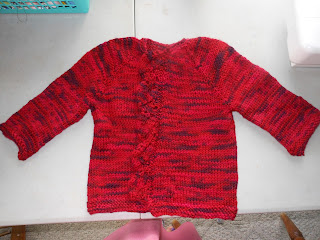Fence Critic
I've become a fence critic. It's one of those little quirks you notice about yourself after you start farming (or for that matter, doing any form of honest work). Or at least, when you're a pretentious southerner to whom everything (no matter how insignificant) is an art to be perfected, everybody else's work is fair game for vicious, merciless criticism. How else would you feel good about your own shoddy work? Every farm I see, I find myself examining the quality of the corner posts, number of strands of barbed wire, spacing of t-posts, etc - and much to the exasperation of The Russian (judging by her attempts to garrote me with a spare shawl), criticizing all of it in extreme detail.
There are a lot of different techniques to building a good fence. Some work better than others, and of course it all depends on what kind of fence you're running, what kind of animal you're keeping, what kind of soil you have, and (most important in my case) your aversion to anything resembling work. What surprises me is how many really poor fences there are out there (among them, of course, plenty of mine - especially the first ones). Here's my method - it has worked pretty well on the few thousand rods of fence we've run so far. All methods are subject to change of course, especially after a passing dragonfly decides to take a breather on a t-post and brings down a few hundred hards of the perimeter.
Barbed wire is all we really need for cattle. (Hogs take a little more work; more on that in a minute). That makes it a little easier than running straight field fence; we've had pretty good results from sinking 6-8 inch posts in 36 inches of concrete (TN clay makes any other setting unacceptable in my opinion), t-posts 12-15 feet apart, and 4 strands of wire. Anything more than 4 strands of wire (the old-timers will tell you always run 5; that way if one breaks you're covered - but I'm lazy and cheap), and you should be doubling up your corner posts at least. Unless we can't get a post at least 36 inches down, we've had pretty good luck with just a single corner post and a brace. I wouldn't trust those fences to something that likes to pound or push on them, though (like a bull - but then, 2000 pounds of pissed-off meat moving at 35 mph can go through pretty much anything it wants to go through - that's kind of like driving your truck into the fence).
For hogs, the same method above works, but you can get away with 3 strands of barbed wire - hogs don't jump fences. We run 4 strands regardless; you never know what else you might need to keep in that paddock. Then, run 2 strands of electric wire on the inside of the posts - the first one about 4 inches off the ground, the second about 8 inches. Power it with the biggest, baddest electric charger you can find (get a buddy to test it of course - just make sure you get a good head start on him since once he's regained consciousness and changed his underwear he'll no doubt want to introduce your face to the nearest hammer). Hogs will touch that fence all of about once, and they'll never (deliberately) touch it again. In fact, we've used just 2 strands of electric fence to separate different hogs in a single paddock before (no barbed wire). Once the hogs figure out where it is, they won't cross that line without a lot of encouragement, even after you remove the wire. Our sow has been around long enough to know what electric fence looks like, so she won't touch it at all on purpose - we could technically just string it and never power it up, and she probably wouldn't ever test it.
We're about to expand into goats, sheep, and (Lord bless us) a stud bull. I think the goats (2 or 3 of them at most) will just stay in a small 60x40 paddock with a fence about 3 miles high and charged up with an old surplus prison electric chair. The old-timers say if your fence won't hold water, it won't hold a goat. In all seriousness, the goats may be short-lived. If they get out and chew something I or The Russian put any value in, they're roast mutton.
I've heard sheep will be ok with the barbed wire. Stacked stone fences with about 250 years' worth of lichen and moss growth on them would be great, but ain't happening in this part of the country (or with a farmer this lazy).
The bull, for now, gets locked in a stall made of adamantine and cryptonite, and equipped with tractor beams, laser-tripped .50-caliber sentry guns, and Patriot missiles. We'll buy him young and treat him right, so he shouldn't be too crazy (though to steal a line of a comedian/farmer whose name I can't remember - as every woman knows, every male species on the planet is bat-**** crazy until castrated).
So that's how we're building our fences. So far it has worked pretty well for us, and apparently the other farmers in the neighborhood think so too - at least, judging by the way they're always gesturing at my fences and talking to their wives, who are calmly trying to garrote them with a spare shawl.
There are a lot of different techniques to building a good fence. Some work better than others, and of course it all depends on what kind of fence you're running, what kind of animal you're keeping, what kind of soil you have, and (most important in my case) your aversion to anything resembling work. What surprises me is how many really poor fences there are out there (among them, of course, plenty of mine - especially the first ones). Here's my method - it has worked pretty well on the few thousand rods of fence we've run so far. All methods are subject to change of course, especially after a passing dragonfly decides to take a breather on a t-post and brings down a few hundred hards of the perimeter.
Barbed wire is all we really need for cattle. (Hogs take a little more work; more on that in a minute). That makes it a little easier than running straight field fence; we've had pretty good results from sinking 6-8 inch posts in 36 inches of concrete (TN clay makes any other setting unacceptable in my opinion), t-posts 12-15 feet apart, and 4 strands of wire. Anything more than 4 strands of wire (the old-timers will tell you always run 5; that way if one breaks you're covered - but I'm lazy and cheap), and you should be doubling up your corner posts at least. Unless we can't get a post at least 36 inches down, we've had pretty good luck with just a single corner post and a brace. I wouldn't trust those fences to something that likes to pound or push on them, though (like a bull - but then, 2000 pounds of pissed-off meat moving at 35 mph can go through pretty much anything it wants to go through - that's kind of like driving your truck into the fence).
For hogs, the same method above works, but you can get away with 3 strands of barbed wire - hogs don't jump fences. We run 4 strands regardless; you never know what else you might need to keep in that paddock. Then, run 2 strands of electric wire on the inside of the posts - the first one about 4 inches off the ground, the second about 8 inches. Power it with the biggest, baddest electric charger you can find (get a buddy to test it of course - just make sure you get a good head start on him since once he's regained consciousness and changed his underwear he'll no doubt want to introduce your face to the nearest hammer). Hogs will touch that fence all of about once, and they'll never (deliberately) touch it again. In fact, we've used just 2 strands of electric fence to separate different hogs in a single paddock before (no barbed wire). Once the hogs figure out where it is, they won't cross that line without a lot of encouragement, even after you remove the wire. Our sow has been around long enough to know what electric fence looks like, so she won't touch it at all on purpose - we could technically just string it and never power it up, and she probably wouldn't ever test it.
We're about to expand into goats, sheep, and (Lord bless us) a stud bull. I think the goats (2 or 3 of them at most) will just stay in a small 60x40 paddock with a fence about 3 miles high and charged up with an old surplus prison electric chair. The old-timers say if your fence won't hold water, it won't hold a goat. In all seriousness, the goats may be short-lived. If they get out and chew something I or The Russian put any value in, they're roast mutton.
I've heard sheep will be ok with the barbed wire. Stacked stone fences with about 250 years' worth of lichen and moss growth on them would be great, but ain't happening in this part of the country (or with a farmer this lazy).
The bull, for now, gets locked in a stall made of adamantine and cryptonite, and equipped with tractor beams, laser-tripped .50-caliber sentry guns, and Patriot missiles. We'll buy him young and treat him right, so he shouldn't be too crazy (though to steal a line of a comedian/farmer whose name I can't remember - as every woman knows, every male species on the planet is bat-**** crazy until castrated).
So that's how we're building our fences. So far it has worked pretty well for us, and apparently the other farmers in the neighborhood think so too - at least, judging by the way they're always gesturing at my fences and talking to their wives, who are calmly trying to garrote them with a spare shawl.


We-e-l--l-l-l. My grandma used to say you could tell what kind a farmer a person was by their fences. My mother said the same thing. And they both lived in Washington State. And when I drive through the country to visit my mother, I, too, find myself looking at the fences. Glad you told me you live in the South. Might have thought that corner leaning post belonged to your fence.
ReplyDelete